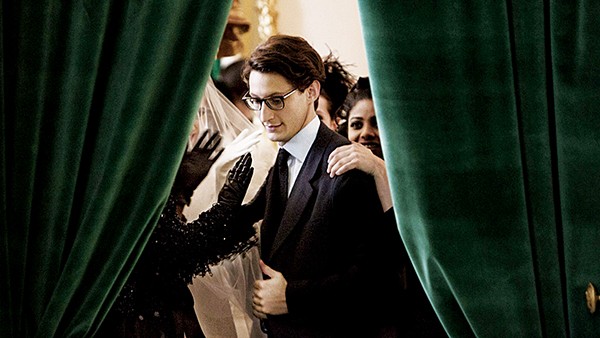Although it’s two-and-a-half hours long, Saint Laurent is, thanks to its brilliant surfaces and luxurious aimlessness, pleasurably sensuous and frustratingly sketchy. You probably won’t feel anything but boredom and relief immediately after you’ve seen it, though. But give it enough time to slink around inside your brain and caress your neural tissues and its pleasures eventually emerge.
Surprisingly, director/co-writer Bertrand Bonello’s epically mundane picture about 10 years in the life of a great fashion designer is the second Yves Saint Laurent biopic released in the last two years. Jill Lespert’s 2014 Yves Saint Laurent managed to win both the approval of Saint Laurent’s business partner and former lover Pierre Bergé and the right to use some original designs and outfits from the YSL archive. Bonello’s film is thus the “unauthorized” version of Saint Laurent’s life, but its refusal to follow the biopic’s traditional rise-and-fall sine curves more than compensates for any sartorial inaccuracies or knockoffs.

Gaspard Ulliel
Much like Mike Leigh’s enlightening and exhausting Mr. Turner, Saint Laurent attempts to get at its subject (embodied here by Gaspard Ulliel) through the work he did rather than the stories others told about him. Instead of rehashing those inspirational triumphs against all odds that we’ve come to dread from such films, Bonello offers several isolated scenes of unexpected pithiness and power. An early split-screen montage of Saint Laurent’s influential 1968 and 1971 lines juxtaposes sleek gamines modeling his latest creations with news footage of Black Panthers and anti-war riots. Interesting times, those — one group dressed like soldiers to battle injustice while another group dressed like scientists to contemplate sleeve lengths.
At every turn, important information about Saint Laurent’s life and career trajectory is ignored, abstracted, or repeated until it loses all meaning. During one crucial business meeting, the focus slowly shifts from a discussion of branding and intellectual property to the straggly bangs and bored countenance of a female translator. “Who is this woman?” replaces “Will YSL be able to secure his naming rights?” as the scene’s chief mystery. We never get an answer.
Similarly, Saint Laurent’s mastery of all things stylish is always assumed. But Bonello includes only one long take where Saint Laurent transforms a woman (Valeria Bruni Tedeschi) from a mousy lady to a regal diva with a few short instructions that reaffirm his elfin confidence and his impeccable taste.
One of the few concessions to conventional biopics involves Saint Laurent’s affair with Jacques de Bascher (Louis Garrel), a dangerous type whose free spirit enrages Bergé (Jérémie Renier). But the film succinctly explains YSL’s attraction: his drugged make-out session with Jacques is far sexier than an earlier game of sexual hide-and-seek with his friend.
In short, Saint Laurent is like a volume of Proust’s In Search of Lost Time if Proust was a nearly silent figure whose genius was expressed not through long sentences but through fabrics, colors, and patterns.